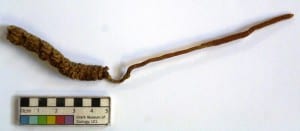Specimen of the Week: Week 148
By zcqsrti, on 11 August 2014
 Zombies aren’t real… or are they? In the world of nature, pretty much anything you come up with already exists: What’s that, a lizard that shoots blood out of its eyes? Yup, that’s been done. What about a toad with babies that burst out its back? Nah, you have to be more creative than that!
Zombies aren’t real… or are they? In the world of nature, pretty much anything you come up with already exists: What’s that, a lizard that shoots blood out of its eyes? Yup, that’s been done. What about a toad with babies that burst out its back? Nah, you have to be more creative than that!
But zombies? Practically anything along the subject makes me prance around like a toddler, combine them with one of my other most favourite things in the world – insects – and I’m a giddy puddle.
Boy, this is a treat for you guys! It’s our first non-zoological specimen of the week. That is, if you don’t count the fact that there’s a dirty great big caterpillar stuck to it, and no, this isn’t a case of the mysterious battery-stuffing opossum maniac up to their usual museum antics again with the Pritt-Stick; the two are fused in a macabre display of harmony, mutual love and zombification.
This specimen of the week is…
**The Cordyceps-infected ghost moth caterpillar**
1) This week’s specimen features a caterpillar of a Hepialid moth infected with a species of Cordyceps fungus. You would be forgiven for saying that this specimen is gruesome; because, frankly even for nature’s dirty standards, it is.
The head of the innocent caterpillar has exploded into a fungal stalk of over twice its length and the whole body has hardened, leaving a husk of mushroomy matter called sclerotium. I can tell you, with great degrees of certainty, that this caterpillar isn’t becoming a beautiful ghost moth anytime soon (or at least if it does, I’ll be slightly surprised because I poked the glass of its jar a little and it didn’t spring into a state of zombified undeadness).
2) Cordyceps is a genus of (roughly) 400 species that belong to Ascomycota; the largest phylum of fungi containing over 64,000 species. Members of this phylum have a fruiting body called the ascocarp where reproductive spores are released… It’s these structures that make the Cordyceps a particularly nefarious genus, in fact the term ‘Cordyceps’ itself is derived from Latin words meaning ‘Club’ and ‘Head’; reflective of this morbid fruiting body shape.

A rather spooky infection.
Image Erich G. Vallery, USDA Forest Service – SRS-4552,
Bugwood.org / CC BY 3.0 via Wikimedia Commons
3) All species of Cordyceps are endoparisitoids, infecting the internal systems of their hosts and ultimately resulting in their slow grizzly demise. Once infected, spreading networks of fibres called hyphae develop within the host. These interacting fungal structures make up the mycelium, the part of the fungus in charge of absorbing internal fluids and nutrients while the infected still lives. These slowly take over the host’s body by replacing internal tissues until, once fully developed, ascocarps erupt out of the exoskeleton in many different shapes and forms, ready to infect other unsuspecting victims.
4) Some species of Cordyceps have completely mastered the art of zombification. Ophiocordyceps unilateralis is a species first discovered by Alfred Russel Wallace in 1849 and is otherwise aptly known as the ‘zombie fungus’. This charming assassin extends its phenotype beyond the limitations of its own and gains the control of an unsuspecting ant. The newly infected ant climbs high up a nearby blade of grass and clamps down in place with its mandibles; here there is optimum temperature and humidity for the growth of the Cordyceps fungus. From the undead head of the ant a single long finger-like ascocarp grows, releasing spores to infect all its little tiny ant buddies on the forest floor. Other ants are even able to recognise when another has been tainted with the dreaded Cordyceps; they have been seen carrying off the newly infected individuals away from the colony to reduce infection chances. Here is a video of it for those whose appetites have been whetted:
5) Cordyceps have been used as an ancient Chinese medicine for thousands of years. In fact the 1993 Chinese female athletics team used a tonic containing Cordyceps sinensis during the Chinese National Athletic Championship. The team set an astonishing amount of world records and the source of their great success was thought to be down to this bizarre tonic when no traces of illegal substances were found.
Asides from all this hoo-ha, the medicinal properties of Cordyceps are still less scientifically understood; though, as is the case with many weird things in nature, there are isolable chemicals that look pretty awesome. One such compound is Cordycepin, an organic derivative of the DNA nucleoside adenosine (otherwise flashily known as 3′-deoxyadenosine) extracted from C. sinensis and C. militaris. This chemical has been shown to have anti-cancer properties and leukemic cell cytotoxicity in vitro conditions.
Bonus fact 6) The cheery nature of Cordyceps fungus has influenced many minds and its fungal dominion can be seen across many elements of popular culture. In Naughty Dog’s action-adventure survival horror videogame The Last of Us, a variant strain of Cordyceps infects humanity and wipes out most of civilisation. Soon enough, all that’s left is a post-apocalyptic wasteland full of botched settlements, nomadic survivor groups, bandits and (of course) echolocating mushroom zombies. The game was a huge success, selling over 1.3 million units in its first week of release; entirely down to the fact that everybody loves a bit of Cordyceps.
Sadly, in the world of children’s books, The Very Hungry Fungus was a less successful sequel to the well-known The Very Hungry Caterpillar having been deemed a little too morbid for its target audience by critics.
Rowan Tinker is Visitor Services Assistant at the Grant Museum of Zoology, and a UCL Natural Sciences student
One Response to “Specimen of the Week: Week 148”
- 1
 Close
Close




A grisly and fascinating article,thanks Rowan